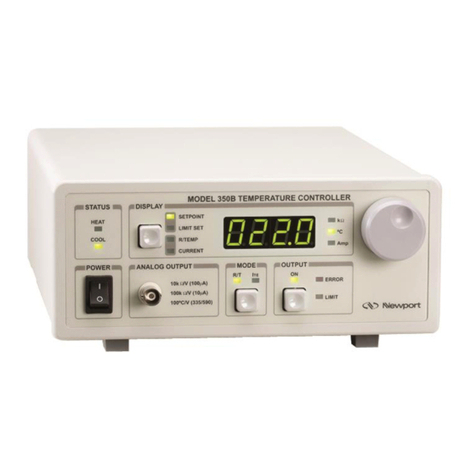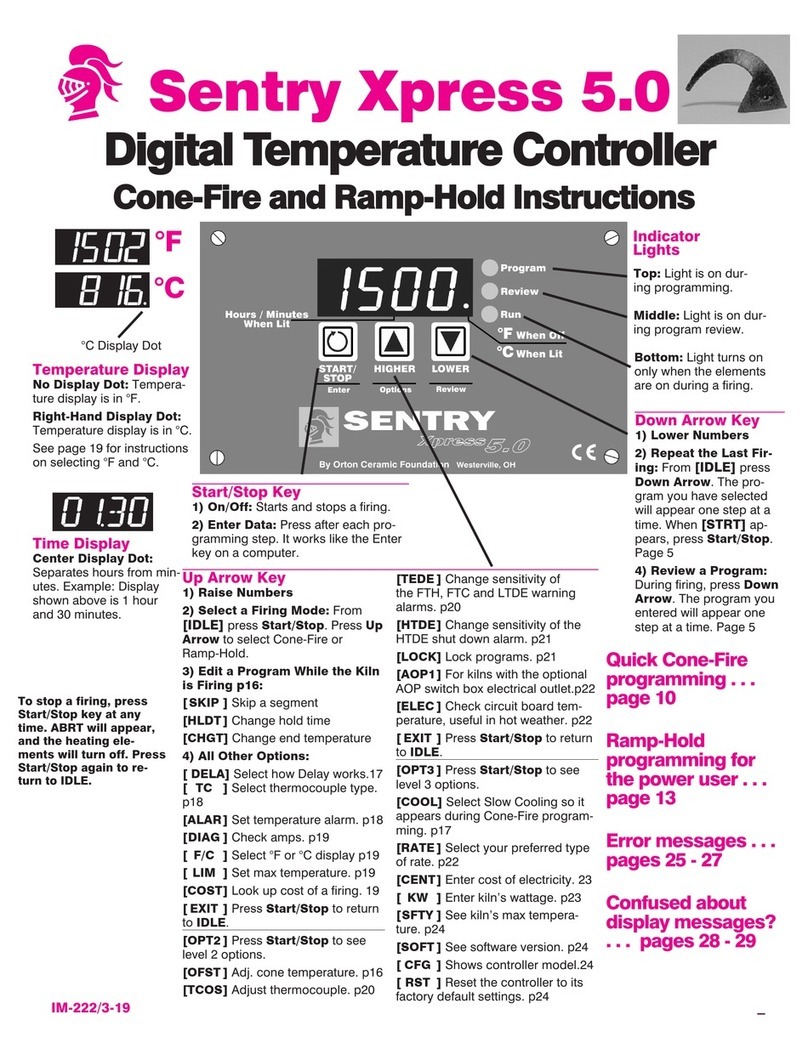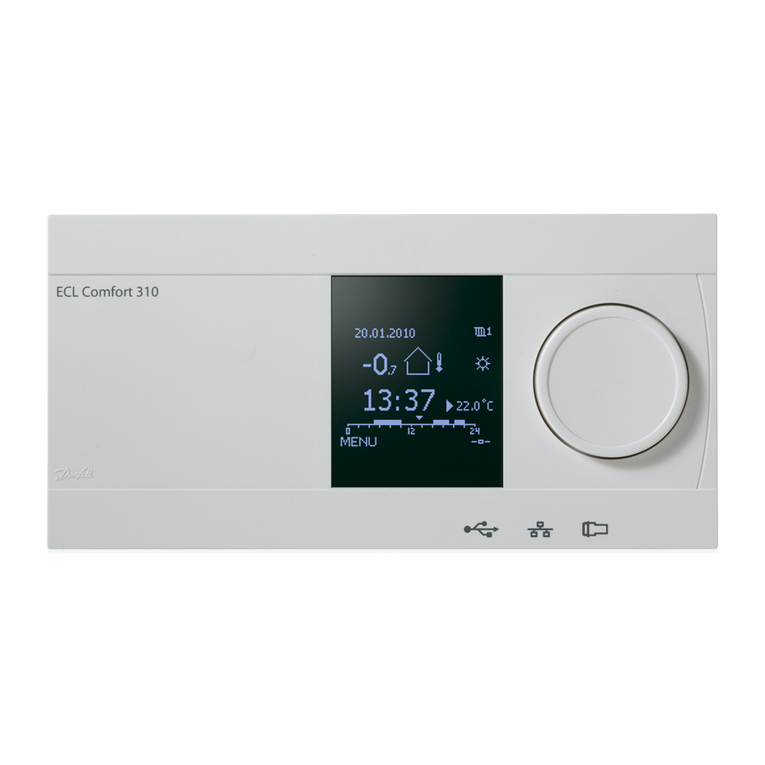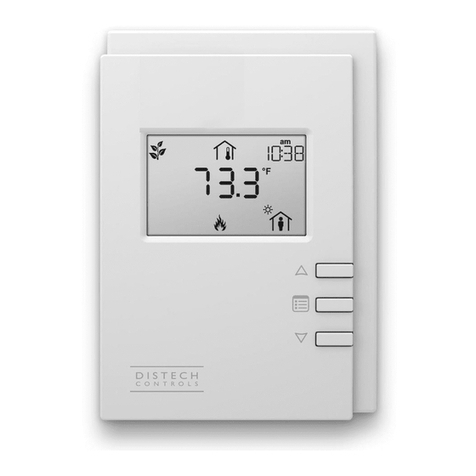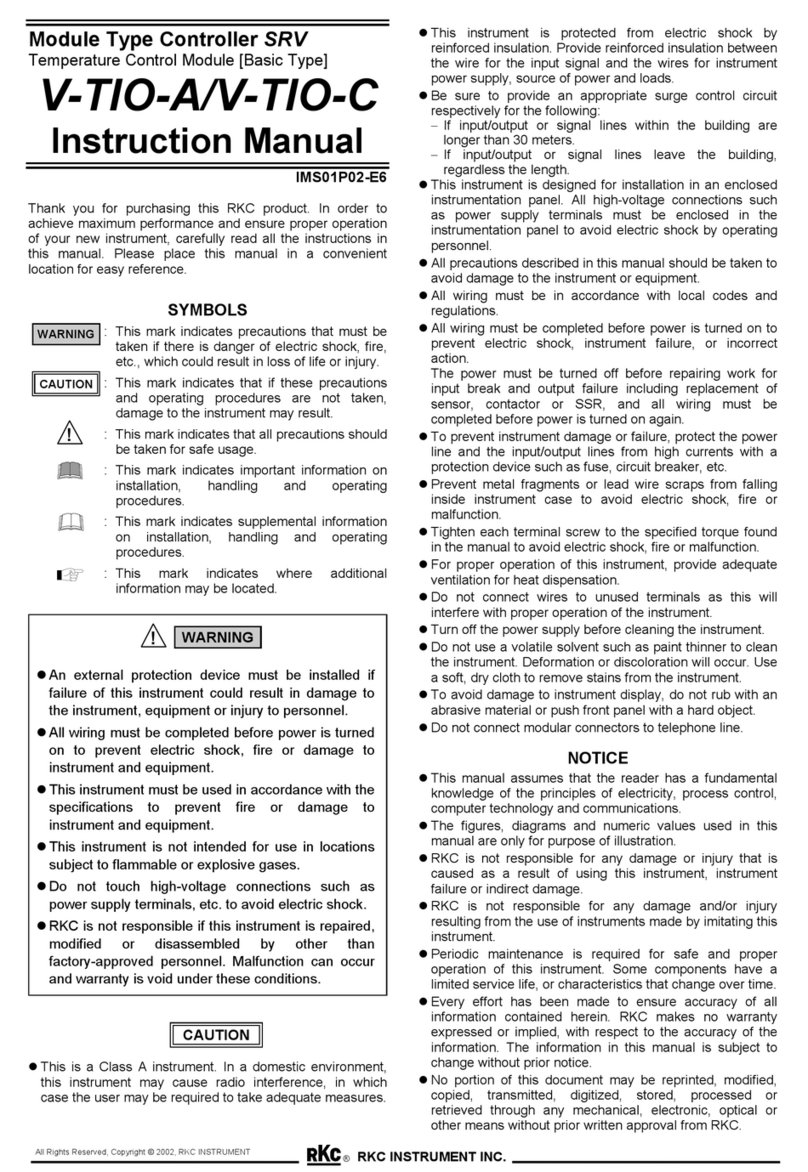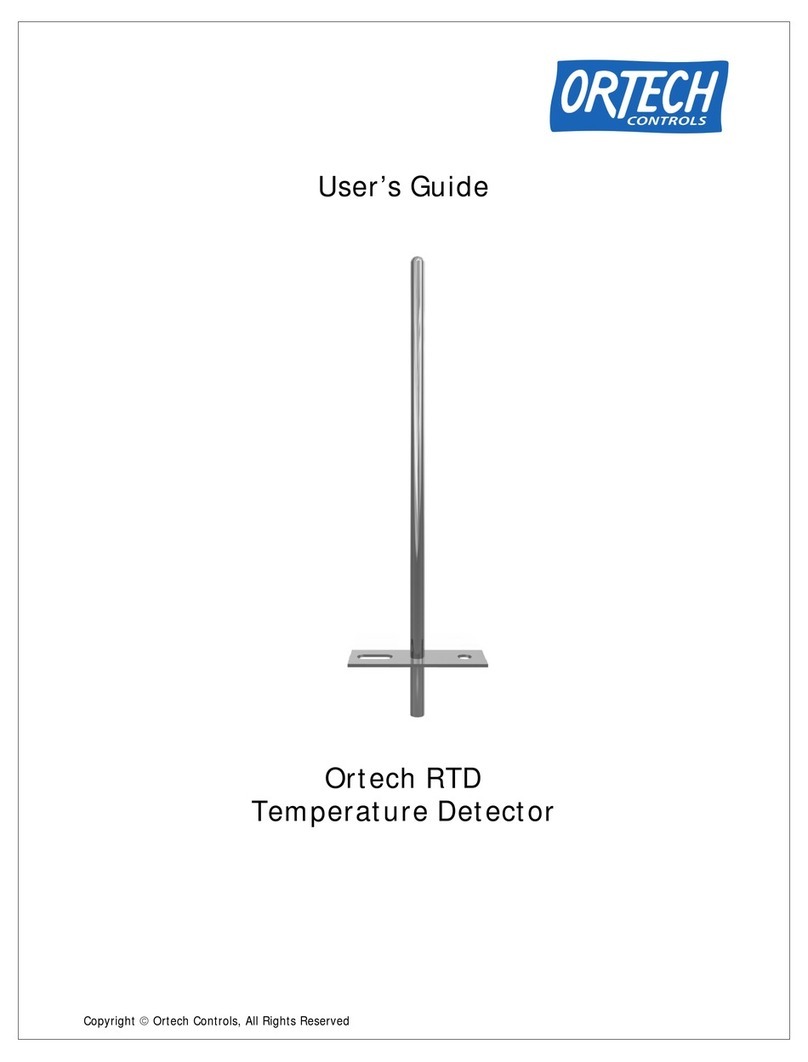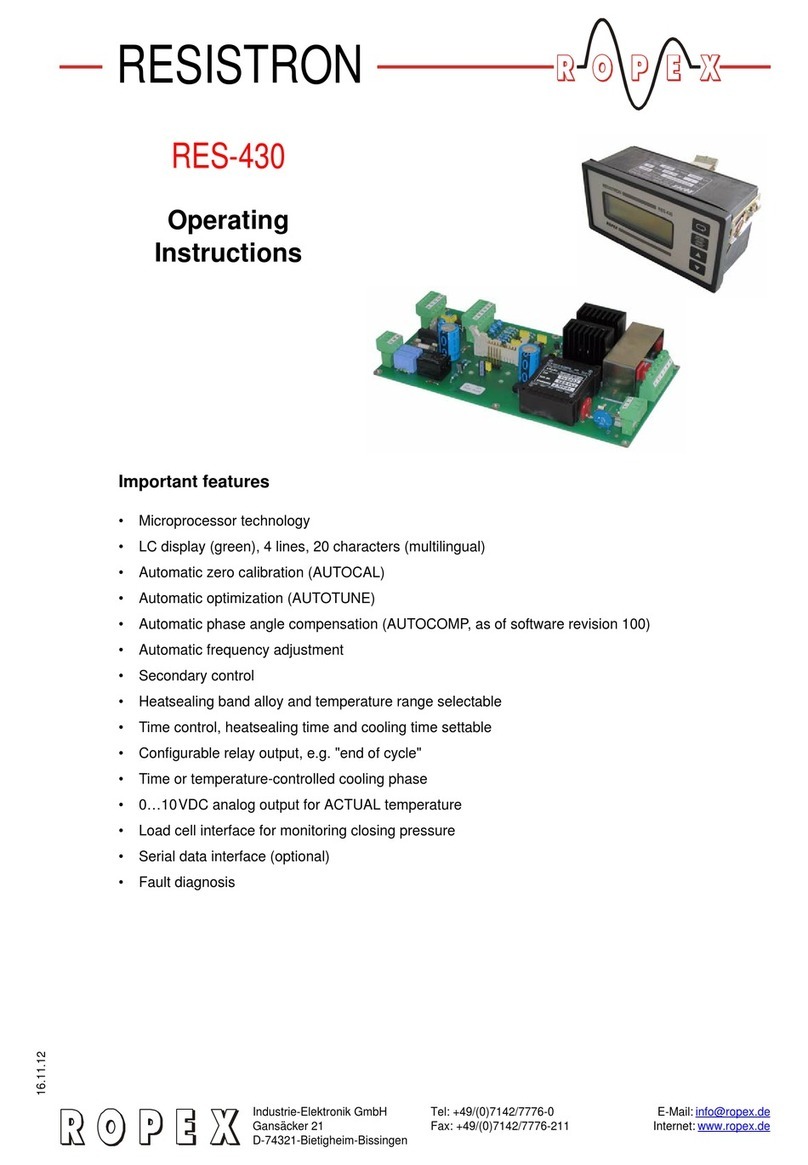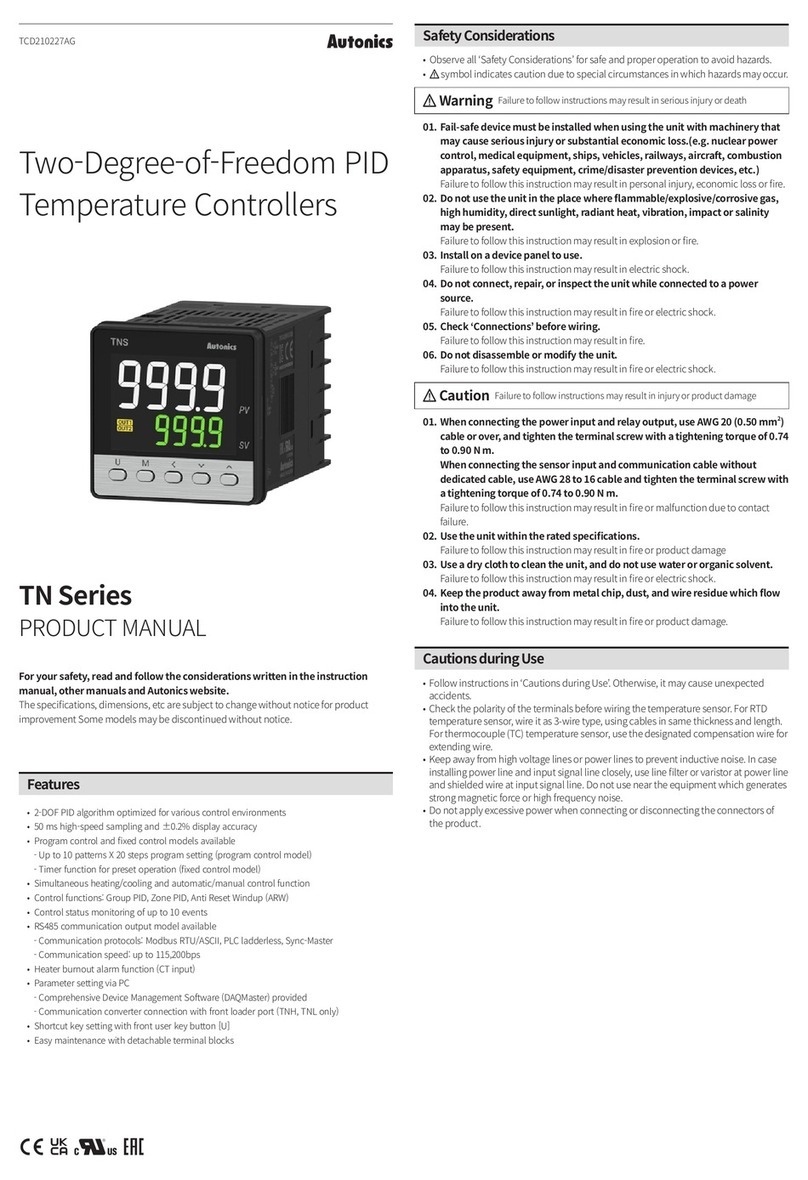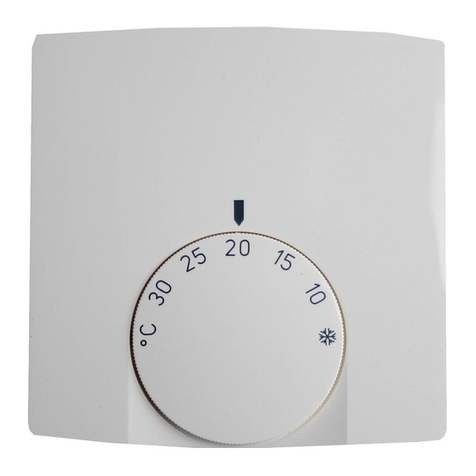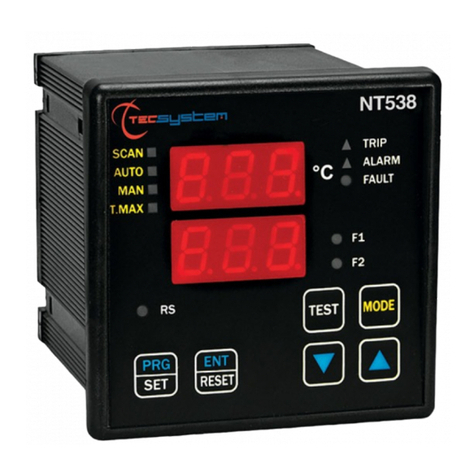ThermoControl HRT 6015-50 User manual

ThermoControl Temperature Controller
Electronic temperature controller with timer (clock controller) for flush mounting and for smart
function (this function sets the time at which the comfort temperature should be reached)
Universal controller HRT 6015-50 for optional
use as
Floor temperature controller 10 to 60 °C,
Room temperature controller 5 to 30 °C
Room temperature controller 5 to 30 °C
with floor temperature monitoring
Room temperature controller 5 to 30 °C
Floor temperature controller 10 to 40 °C
The room temperature controllers can also be used as cooling controllers (see “Commissioning”).
Smart operation is activated on all controller types.
Also available as master controller (option) for connecting clockless bi-metal and/or electrical controllers as
satellites.
Device view
Figure 1

Safety instructions
Only authorised electricians are permitted to work on a 230 V mains voltage. The safety regulations
of the VDE and the local electrical utility company must be observed
The connection work stated in these instructions must not be carried out when the mains voltage is
switched on.
A 30 mA residual current circuit-breaker must be used in humid areas (such as bathrooms) in
accordance with VDE 0100.
The mains supply must be protected by means of a miniature circuit-breaker (16 A).
A terminal cross-section of 2.5 mm2 must be used for a heating output of 3 kW or higher.
Description/application range
The electronic temperature controller with timer control is designed for controlling the floor
temperature and/or the room temperature in individual rooms.
It can be used, for example, for electrical direct heating (floor or convectors), supplementary heating
for floor background heating in bathrooms, electrical perimeter heating or warm water heating with
control valves. The controlled variable is either the room temperature using an integrated room
temperature sensor or the floor temperature using the supplied floor temperature sensor at the level
of the heating mat.
AC 230V normally closed control valves are used for the control of warm water heating systems.
Technical data
Colour alpine white
Degree of protection IP 30
Protection class II
Mains voltage 230 V +/- 10%, 50 Hz
Room controller versions 5 to 30 °C
Floor controller version 10 to 40 °C
Max. switching current 12 (4 ) A floor controller
Max. switching capacity 2.7 kW floor controller
Switch temperature differential 0.7 K
Switch contact Opens on overtemperature
Temperature sensor NTC to DIN 44574
Temperature sensor cable 4 m length, max. 8 mm
Directives/Standards/Approvals EMC Directive 89/336/EEC
EU Low-Voltage Directive 73/23/EEC
Ambient temperature -10 to + 40 °C
Energy class IV = 2.0%

Installation instructions - Mounting options
Installing the floor temperature sensor
Install the floor sensor in a separate protective tube at the heating mat level centrally between the
heating cables.
ATTENTION: Apart from when only room temperature control is required, a floor temperature sensor
must always be connected. Failure to do so will turn off the heater.
With room temperature control systems with floor heating, it must be ensured that the floor is not
overheated. With the universal controller it is possible to implement a temperature monitor function
(floor temperature monitoring) by using the floor sensor (default setting). The floor limit temperature
that is not to be exceeded can be set in the controller.
(see “Changing controller options”)
Installing temperature controllers
Installation in standard conduit box. When using additional intermediate terminals
the use of a deep conduit box is recommended.
Mounting height: Approx. 1.5 m above floor.
Avoid exposure to water.
When used as a room temperature controller, ensure that normal room air reaches the controller
without obstruction. The controller should not be mounted in shelf walls, under curtains or on outdoor
walls.
External heat from sunlight and draughts from windows and doors impair the accuracy of the
controller and should be avoided.
The frame can be exchanged for switch frames (if required with intermediate frame) from Busch-
Jaeger, Berker or similar, in order to adapt the controller to different switch systems
Preparation for installation in the conduit box
Figure 2
-
+
C
~
~
~
1
25
4
3
20 4 6 8 10 12
12 16 20 22 24
1814
50 mm
50 mm
80 mm
80 mm
Step 4: Remove round cover
Open out from bottom left to top right
Step 3: Remove cover
Step 1: Carefully remove the
adjustment dial with a screwdriver
Step 2: Undo screw
Deph 42 mm
Mounting depth in conduit box 25 mm

Electrical connection
Figure 3 and 4
L N PE
T
A
F
F
N
L
1
N
L
Heating
NTC
230V~
mains supply
Floor temperature sensor
Master output
(optional)
L N PE
T
A
F
F
N
L
1
N
L
NTC
230V~
mains
Floor temperature sensor
Heating mat
Master output
(optional)

Figure 5
Commissioning
If a room temperature controller is to be used as a cooling controller, remove jumper 1 (figure 7) with
a long nose pliers and fit it in the two upper sockets. To deactivate the smart function remove jumper
2 (figure 7) and fit it into the two sockets on the right.
The universal controller is factory set as a floor temperature controller (10 to 60°C).
For changes see “Changing controller options”. If you have moved a jumper or changed the rotary
switch setting on the universal controller, the Reset button must be pressed after the und cover is
fitted and the mains voltage is switched on.
Then set the Heating On/Off switch on the controller to the
position (Figure 1). Setting the time and weekday (see “Programming”)
Move the switch to the required position.
= Continuous operation (heating system controls a constant heating temperature)
= Timed operation, the preset heating program no. 1 is now active.

Mon ... Fri Sat, Sun Type
No. 1 06.00 ... 08.00 07.00 ... 09.00 Bath
19.00 ... 22.00 20.00 ... 23.00 room
The display shows the current heating program
and the current time. The bar corresponding to
this time flashes at the same time.
For other heating programs see
“Programming”
Long bars = Heating temperature
Short bars = Setback temperature
The controller switches to heating operation at the indicated times (long bars).
In other words, heating will be activated until the heating temperature set on the dial is reached, when
it is then kept constant by the controller. At the other times, the device regulates the temperature to
the setback temperature value, i.e. the heating is switched back on if it goes below the defined
setback temperature (default 15 °C).
For changing the setback temperature, see “Changing the setback temperature”
Setting the required setback temperature with the adjustment dial (Figure 1)
With floor temperature control 10 to 60 °C (numbers on the adjustment dial 1 to 6)
1 = approx. 10 °C ; 2 = approx. 20 °C etc.
With room temperature control 5 to 30 °C (numbers on the adjustment dial 1 to 6)
1 = approx. 5 °C ; 2 = approx. 10 °C etc.
Note The heating temperature cannot be shown on the display.
:
18
35
0
2
4
8
10
12
24
22
20
18
16
14
12
6
1
Heating program Mo-Fr

Programming
Remember when programming that any changes are accepted automatically after
10 seconds!
A change, for example between time and date is not possible in this time.
The device automatically switches to operating status.
Setting the time
Note: The Time and date are automatically set and reset if a flush mounted radio clock is connected.
Manual time and date setting is not necessary.
Set the switch to the Sun symbol (all bars are now long on the display). Hold down the C
button and press the + button. You can now release the C button and set the time with the + or –
buttons. Holding the button down for a long time first changes the setting slowly and then increasingly
faster.
:
18 35
0 2 46810 12
2422
20
1816
12 14
Example with time setting
18 : 35
Summer/winter time changes must be carried out manually.
Weekday setting
Leave the switch at the Sun position. Hold down the C button and press the –button. You can now
release the C button and set the current weekday with the + or –buttons.
1 = Monday, 2 = Tuesday, ... 7 = Sunday.
Examples:
2
0246810 12
12 14 16 18 20 24
22
Weekday
Example
2 = Tuesday

Programming
Other heating programs
Set the switch to the Clock position. Hold down the C button and select one of the four preset
programs or the personal 'E' user program by pressing the + button several times as required. The
program number is shown on the left of the display, and shows 'Sa, So' (= Saturday, Sunday) for
weekend programs
Mon ... Fri Sat, Sun Type
No. 1 06.00 ... 08.00 07.00 ... 09.00 Bath
19.00 ... 22.00 20.00 ... 23.00 room
No. 2 06.00 ... 08.00 08.00 ... 22.00 Children's
14.00 ... 22.00 room
No. 3 05.30 ... 07.30 07.00 ... 23.00 Employees
17.00 ... 23.00
No. 4 06.00 ... 23.00 06.00 ... 23.00 Standard
No. E your personally created program
Creating an 'E' user program
Call up the 'E' user program (default setting: all bars short). Select the bar to be changed (now
flashing quickly) by pressing the + or - button. Change the bar by pressing the C button. The next bar
will then flash and can likewise be changed. In this way, all the bars can be switched from setback to
heating temperature and vice versa. The completed program will be automatically saved and
activated as a user program 10 seconds after the last actuation. It can be changed at any time if
required. On a weekday, the user program applies to all weekdays. If you wish to create an 'E' user
program for the weekend, hold down the + button and press the - button once. The user program is
now displayed for the weekend (default: all bars short), and 'Sa,So' appears on the left of the display.
Now create the user program for the weekends in the described manner. The program is saved 10
seconds after the last button actuation and the controller returns to weekday operation. (A personal
program for weekdays can likewise be created on weekends).

Programming
Changing the setback temperature
(default setting 15 °C)
Set the switch to the Sun symbol (all bars are now long on the display).
Set the new setback temperature required with the adjustment dial (see Figure 1).
Hold down the + button and press the –button once.
The new setback temperature is now saved and is shown briefly on the display for control purposes.
It is retained when the program is changed.
Turn the adjustment dial back to the required heating temperature and if necessary move up the slide
switch to the clock position.
Min. set-back temperature on floor temperature controller: 10 °C
Min. set-back temperature on room temperature controller: 5 °C
Changing the controller options of the universal controller
Figure 6
Figure 7
Step 4:
Set the required controller option here
J1 (Jumper)
Heating / cooling
J2 (Jumper)
Smart mode
-
+
C
~
~
~
1
2
5
4
3
2
0
4
6
8
10
12
12
16
20
22
24
18
14
Step 3: remove cover
Step 1: carefully remove adjustment dial
with a small screwdriver
Set 2: undo screw

Changing the controller options of the universal controller with rotary switch
Position 0 Floor temperature controller 10 to 60 °C
In this position the room temperature controller is switched off
Position 1 Room temperature controller 5 to 30 °C
In this position the floor temperature controller is switched off
Room temperature controller 5 to 30 °C with optional
floor limit temperature
Position 2 28 °C for sensitive parquet flooring or laminate
Position 3 31 °C optional intermediate value
Position 4 34 °C optional intermediate value
Position 5 44 °C to DIN 44 576 for electrical floor direct heating
(default setting)
Position 6 55°C to DIN 44 576 for electrical perimeter heating
Position 7 Reserve
Attention!
The Reset button must be pressed after a controller option is changed.
The change is activated automatically after approx. 60 to 90 secs. If necessary reset the personal 'E'
user program and the set-back temperature.
Reset button
Pressing the Reset button sets the controller back to the default setting.
•The user program E is deleted
•Set-back temperature = 15 °C
•Date/ time is unchanged
•The set controller option is unchanged
Limiting the temperature range
The temperature setting range can be mechanically limited by reducing the rotation range of the
adjustment dial. To do this, proceed as follows:
Remove the adjustment dial carefully with a screwdriver.
Pull out the range limit stop pin from the housing cover using a long nose pliers. Rotate the wheels to
limit the rotation angle as required.
Insert the stop pin and then refit the adjustment dial back in position.
Figure 8
-
+
C
~
~
~
1
2
5
4
3
2
0
4
6
8
10
12
12
16
20
22
24
18
14
Stept 1: Carefully remove the adjustment dial with
screwdriver
Stop pin

Mains supply failure
The heater switches off in the event of a mains supply failure and the upper bar of the
display flashes. The device resumes its previous operation if the mains voltage is restored within
approx. 1 to 1 ½ days. If the mains supply failure is longer, the time and weekday must be reset and
the 'E' user program may have to be re-entered. The set-back temperature must also be
reprogrammed if this was altered.
Short-circuit or interruption in the sensor line: The heating system is disconnected and the LED
flashes. CAUTION: In the event of a fault, the mains voltage may still be present on the sensor line
Special master controllers for connecting satellites
All controllers listed can be supplied as master controllers for connecting satellites. The TA output can
be used to connect virtually any number of clockless temperature controllers, e.g. commercially
available bimetal controllers with their L set-back input TA as satellites. If the master controller with its
timer switches to set-back operation, all satellites do the same.
Troubleshooting
Diagnosis
Possible cause
Solution
No display visible
Heating system not switched on
Heating system does not switch
on, the entire display flashes
Heating system does not switch
on, LED flashes
Device is not working correctly
Mains voltage not connected
Device possibly on setback mode or
floor monitor has responded
Mains supply failure
Floor temperature sensor faulty
Device fault caused by lightning or
overvoltage
Switch on mains voltage
Check setback mode or wait until
the floor has cooled down
Check mains voltage
Replace floor temperature sensor
Press Reset button, reset the
device
Your personal 'E' user program
Mon ... Fri Sat, Sun
No. E ......................... .........................

Reservation of right
Subject to technical modifications.
Compensation cannot be claimed on account of modifications, errors or print errors.
Table of contents
Popular Temperature Controllers manuals by other brands
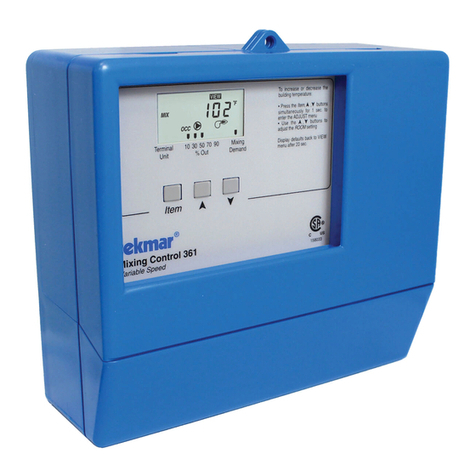
Tekmar
Tekmar Mixing Control 361 Data brochure

Elotech
Elotech R4000 Description and operating manual

BAPI
BAPI BA-WTH-SO Installation and operation instruction
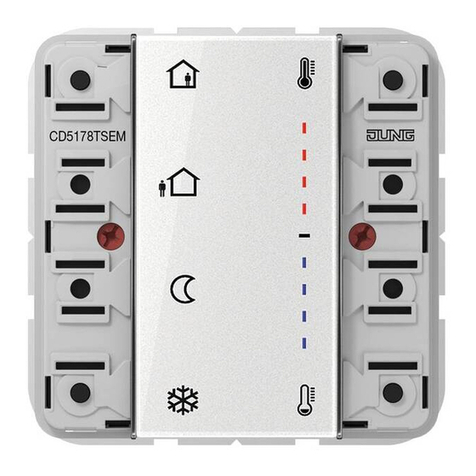
Jung
Jung KNX 5178TSM-01 Series operating instructions
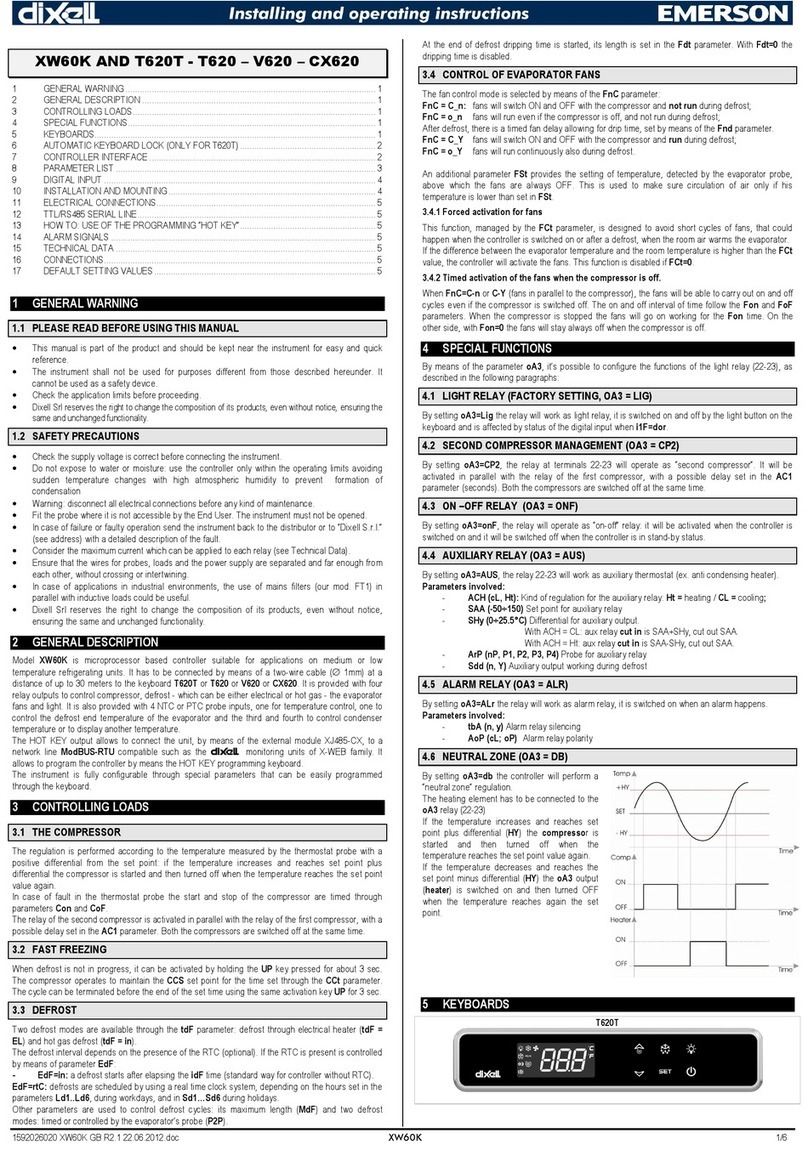
dixell
dixell XW60K Installation and operating instructions

Pentair
Pentair Raychem RTD-200 installation instructions
